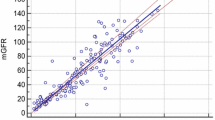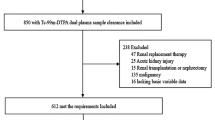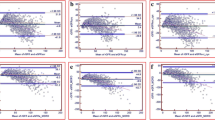Abstract
Background
To evaluate the clinical practicability of the Xiangya equation in estimating glomerular filtration rate (GFR) and compare with the Asian modified Chronic Kidney Disease-Epidemiology Collaboration (CKD-EPI) equation, assessing whether the Xiangya equation could replace the Asian modified CKD-EPI equation as the preferred method for predicting GFR in the Chinese CKD patients in an external validation study.
Methods
The GFR was determined simultaneously by two methods: (a) the Asian modified CKD-EPI equation (GFRCKD-EPI); (b) the Xiangya equation (GFRXiangya); diagnostic performance of the two models was compared by the regression analysis, the Bland–Altman plot, bias, precision and P30 under the background of 99mTc-diethylenetriaminepentaacetic acid (99mTc-DTPA) dual plasma sample clearance method as reference method for GFR measurement (mGFR).
Results
A total of 158 Chinese CKD patients were included in our external study. The GFRXiangya was highly related with mGFR, with the correlation coefficient of 0.92. The regression equation was GFRXiangya = 0.55*mGFR + 28.25, where the regression coefficient was far away from one and the intercept was wide. Compared with the Asian modified CKD-EPI equation, the performance of the Xiangya equation demonstrated a poorer bias (9.5 vs − 3.3 ml/min/1.73 m2, P < 0.001), an inferior precision (23.9 vs 13.0 ml/min/1.73 m2, P < 0.001), a lower P30 (51.3% vs 73.4%, P < 0.001) and a wider 95% limit of agreement in Bland–Altman analysis (65.0 vs 44.9 ml/min/1.73 m2).
Conclusion
Due to relatively inferior performance, the Xiangya equation could not replace the Asian modified CKD-EPI equation in estimating GFR in Chinese patients with chronic kidney disease in our external cohort.




Similar content being viewed by others
References
Eckardt KU, Coresh J, Devuyst O et al (2013) Evolving importance of kidney disease: from subspecialty to global health burden. Lancet 382(9887):158–169
GBD Chronic Kidney Disease Collaboration (2020) Global, regional, and national burden of chronic kidney disease, 1990–2017: a systematic analysis for the Global Burden of Disease Study 2017. Lancet 395(10225):709–733
Levey AS (1990) Measurement of renal function in chronic renal disease. Kidney Int 38(1):167–184
Levey AS, Inker LA (2017) Assessment of glomerular filtration rate in health and disease: a state of the art review. Clin Pharmacol Ther 102(3):405–419
Blaufox MD, Aurell M, Bubeck B et al (1996) Report of the radionuclides in nephrourology committee on renal clearance. J Nucl Med 37(11):1883–1890
Soares AA, Eyff TF, Campani RB et al (2009) Glomerular filtration rate measurement and prediction equations. Clin Chem Lab Med 47(9):1023–1032
Stevens LA, Claybon MA, Schmid CH et al (2011) Evaluation of the chronic kidney disease epidemiology collaboration equation for estimating the glomerular filtration rate in multiple ethnicities. Kidney Int 79(5):555–562
Wang J, Xie P, Huang JM et al (2016) The new Asian modified CKD-EPI equation leads to more accurate GFR estimation in Chinese patients with CKD. Int Urol Nephrol 48(12):2077–2081
Gao JQ, Zhao FG, Huang JM et al (2021) Comparative performance of FAS equation and Asian modified CKD-EPI in the determination of GFR in Chinese patients with CKD with the 99mTc-DTPA plasma clearance as the reference method. Nefrologia (Engl Ed) 41(1):27–33
Li DY, Yin WJ, Yi YH et al (2019) Development and validation of a more accurate estimating equation for glomerular filtration rate in a Chinese population. Kidney Int 95(3):636–646
Kidney Disease: Improving Global Outcomes (KDIGO) CKD Work Group (2013) KDIGO clinical practice guideline for the evaluation and management of chronic kidney disease. Kidney Int Suppl 3:1–150
Xie P, Huang JM, Li Y et al (2017) The modified CKD-EPI equation may be not more accurate than CKD-EPI equation in determining glomerular filtration rate in Chinese patients with chronic kidney disease. J Nephrol 30(3):397–402
Bröchner-Mortensen J (1972) A simple method for the determination of glomerular filtration rate. Scand J Clin Lab Invest 30(3):271–274
Haycock GB, Schwartz GJ, Wisotsky DH (1978) Geometric method for measuring body surface area: a height-weight formula validated in infants, children, and adults. J Pediatr 93(1):62–66
Xie P, Huang JM, Lin HY et al (2013) CDK-EPI equation may be the most proper formula based on creatinine in determining glomerular filtration rate in Chinese patients with chronic kidney disease. Int Urol Nephrol 45(4):1057–1064
Lamb EJ, Stevens PE, Deeks JJ (2015) What is the best glomerular filtration marker to identify people with chronic kidney disease most likely to have poor outcomes? BMJ 350:g7667
Xie P, Li HL, Huang JM et al (2019) Validation of the full-age spectrum equation in the approximation of glomerular filtration rate in Chinese patients with chronic kidney disease. Ren Fail 41(1):467–472
Xie P, Huang JM, Liu XM et al (2013) (99m) Tc-DTPA renal dynamic imaging method may be unsuitable to be used as the reference method in investigating the validity of CDK-EPI equation for determining glomerular filtration rate. PLoS ONE 8(5):e62328
Earley A, Miskulin D, Lamb EJ et al (2012) Estimating equations for glomerular filtration rate in the era of creatinine standardization: a systematic review. Ann Intern Med 156(11):785–795 (W-270, W-271, W-272, W-273, W-274, W-275, W-276, W-277, W-278)
National Kidney Foundation (2002) K/DOQI clinical practice guidelines for chronic kidney disease: evaluation, classification, and stratification. Am J Kidney Dis 39(2 Suppl 1):S1-266
Funding
This paper was partially supported by Health and Family Planning Commission of Hebei Province (20190619).
Author information
Authors and Affiliations
Contributions
WL: provided and used the software. PX and LZ: conceived and designed the experiments. PX, JMH, LGW, MCG and FG: performed the experiments. WL and LZ: wrote the paper.
Corresponding author
Ethics declarations
Conflict of interest
The authors have declared that no competing interests exist.
Additional information
Publisher's Note
Springer Nature remains neutral with regard to jurisdictional claims in published maps and institutional affiliations.
Rights and permissions
About this article
Cite this article
Liu, W., Zhao, L., Huang, Jm. et al. The Xiangya equation could not replace the Asian modified CKD-EPI equation in estimating glomerular filtration rate in Chinese patients with chronic kidney disease. Int Urol Nephrol 54, 3025–3031 (2022). https://doi.org/10.1007/s11255-022-03248-8
Received:
Accepted:
Published:
Issue Date:
DOI: https://doi.org/10.1007/s11255-022-03248-8




